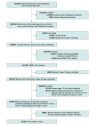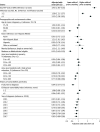Screening History, Stage at Diagnosis, and Mortality in Screen-Detected Breast Cancer
- PMID: 40232715
- PMCID: PMC12000969
- DOI: 10.1001/jamanetworkopen.2025.5322
Screening History, Stage at Diagnosis, and Mortality in Screen-Detected Breast Cancer
Abstract
Importance: Screening mammography promotes early detection of breast cancer and is associated with reduced breast cancer mortality. Screening history prior to diagnosis may impact stage at diagnosis and breast cancer mortality but has not been comprehensively examined within a diverse US cohort.
Objective: To determine whether having a prior screening is associated with earlier stage at breast cancer diagnosis and lower breast cancer-specific mortality.
Design, setting, and participants: This cohort study used linked Surveillance, Epidemiology, and End Results-Medicare data of women aged at least 70 years, diagnosed with estrogen receptor-positive or human epidermal growth factor receptor 2-negative breast cancer from 2010 to 2017, and enrolled in fee-for-service Medicare Parts A and B from 5 years prior to through 1 year after diagnosis. Data were analyzed from March 1 to September 18, 2024.
Exposure: Presence of 1 or more screening mammograms during the 5 years prior to the mammogram at breast cancer diagnosis.
Main outcomes and measures: Outcomes of interest were stage of breast cancer at diagnosis, dichotomized into very early (T1N0) vs later stage (T2+ or N1+) and breast cancer-specific mortality.
Results: Among 13 028 included women, most had at least 1 prior screening (10 094 women [77.5%]) and were aged between 70 and 79 years (9034 women [69.4%]) and not dual-eligible for Medicare and Medicaid (11 475 women [88.1%]). Additionally, 3812 women (29.3%) were diagnosed with later-stage disease (T2+ or N1+) at the time of diagnosis. In multivariable analyses, prior screening was associated with 54% lower odds of later-stage breast cancer diagnosis (adjusted odds ratio, 0.46; 95% CI, 0.42-0.50) and 36% lower hazard of breast cancer-specific death (adjusted hazard ratio, 0.63; 95% CI, 0.52-0.76) compared with no prior screenin. In the adjusted Cox proportional hazards model, having 3 or 4 prior screenings was associated with 37% reduced hazard of breast cancer-specific mortality compared with having 1 prior screening (adjusted hazard ratio, 0.63; 95% CI, 0.44-0.89).
Conclusions and relevance: In this cohort study of older women with screen-detected estrogen receptor-positive or human epidermal growth factor receptor 2-negative breast cancer, prior screening mammography was associated with earlier stage at breast cancer diagnosis and lower breast cancer mortality. These findings support the potential for routine screening to improve breast cancer outcomes. As with all observational studies, this study is limited by the potential effects of other differences between the screening and nonscreening groups.
Conflict of interest statement
Figures




References
-
- US Census Bureau . Age and sex composition in the United States: 2023. Accessed February 5, 2025. https://www.census.gov/data/tables/2023/demo/age-and-sex/2023-age-sex-co...
-
- Mandelblatt JS, Cronin KA, Bailey S, et al. ; Breast Cancer Working Group of the Cancer Intervention and Surveillance Modeling Network . Effects of mammography screening under different screening schedules: model estimates of potential benefits and harms. Ann Intern Med. 2009;151(10):738-747. doi:10.7326/0003-4819-151-10-200911170-00010 - DOI - PMC - PubMed
Publication types
MeSH terms
LinkOut - more resources
Full Text Sources
Medical
Research Materials

